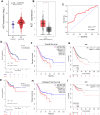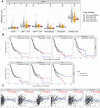AGT May Serve as a Prognostic Biomarker and Correlated with Immune Infiltration in Gastric Cancer
- PMID: 35264871
- PMCID: PMC8899101
- DOI: 10.2147/IJGM.S351662
AGT May Serve as a Prognostic Biomarker and Correlated with Immune Infiltration in Gastric Cancer
Abstract
Purpose: Angiotensinogen (AGT), as a component of the renin-angiotensin system (RAS), is associated with multiple risk factors for gastric cancer (GC). However, the relationship between AGT and tumor-infiltrating lymphocytes in GC remains elusive.
Methods: AGT expression was analyzed based on the Cancer Genome Atlas (TCGA) dataset. Kaplan-Meier curve was employed to assess the role of AGT expression in gastric patients' prognosis. The association between AGT expression and tumor immune infiltration was further evaluated via exploring Tumour Immune Estimation Resource (TIMER) and The Gene Expression Profiling Interactive Analysis (GEPIA). We also used multiple public databases to analyse the aberrant methylation of AGT, construct protein-protein interaction (PPI) and gene ontology (GO) analyses.
Results: AGT was overexpressed in GC tissues compared with normal gastric tissues (P<0.05). High AGT expression related with poorer overall survival of patients with GC, especially in advanced GC patients. Immune infiltration analysis revealed that AGT was associated with several immune cells (including B cells, CD4+ T cells, macrophages), and AGT expression was also associated with the markers of NK cells, TAMs, Tregs, and so on (all P<0.05). Methylation analysis indicated that hypomethylation may lead to abnormal upregulation of the AGT. GO analysis showed that AGT and its related genes were enriched in systemic arterial blood pressure by hormone, regulation of blood volume by renin-angiotensin, NIK/NF-kappaB signaling, ficolin-1-rich granule and so on.
Conclusion: AGT could act as a promising biomarker for prognosis and immune infiltration in GC.
Keywords: angiotensinogen; methylation; prognosis; stomach adenocarcinoma; tumor-infiltrating.
© 2022 Wu et al.
Conflict of interest statement
The authors report no conflicts of interest in this work.
Figures





Similar articles
-
CMA1 is potent prognostic marker and associates with immune infiltration in gastric cancer.Autoimmunity. 2020 Jun;53(4):210-217. doi: 10.1080/08916934.2020.1735371. Epub 2020 Mar 4. Autoimmunity. 2020. PMID: 32129682
-
LAYN Is a Prognostic Biomarker and Correlated With Immune Infiltrates in Gastric and Colon Cancers.Front Immunol. 2019 Jan 29;10:6. doi: 10.3389/fimmu.2019.00006. eCollection 2019. Front Immunol. 2019. PMID: 30761122 Free PMC article.
-
Increased IGFBP7 Expression Correlates with Poor Prognosis and Immune Infiltration in Gastric Cancer.J Cancer. 2021 Jan 1;12(5):1343-1355. doi: 10.7150/jca.50370. eCollection 2021. J Cancer. 2021. PMID: 33531979 Free PMC article.
-
Effect of LAMA4 on Prognosis and Its Correlation with Immune Infiltration in Gastric Cancer.Biomed Res Int. 2021 Aug 9;2021:6428873. doi: 10.1155/2021/6428873. eCollection 2021. Biomed Res Int. 2021. PMID: 34414238 Free PMC article.
-
TIMP2 is associated with prognosis and immune infiltrates of gastric and colon cancer.Int Immunopharmacol. 2022 Sep;110:109008. doi: 10.1016/j.intimp.2022.109008. Epub 2022 Jul 2. Int Immunopharmacol. 2022. PMID: 35792273
Cited by
-
Development and validation of an ARID1A-related immune genes risk model in evaluating prognosis and immune therapeutic efficacy for gastric cancer patients: a translational study.Front Immunol. 2025 Apr 28;16:1541491. doi: 10.3389/fimmu.2025.1541491. eCollection 2025. Front Immunol. 2025. PMID: 40406134 Free PMC article.
-
Identification of immune- and oxidative stress-related signature genes as potential targets for mRNA vaccines for pancreatic cancer patients.Medicine (Baltimore). 2024 Jul 5;103(27):e38666. doi: 10.1097/MD.0000000000038666. Medicine (Baltimore). 2024. PMID: 38968513 Free PMC article.
-
Heterogeneity of hepatocyte dynamics restores liver architecture after chemical, physical or viral damage.Nat Commun. 2024 Feb 10;15(1):1247. doi: 10.1038/s41467-024-45439-0. Nat Commun. 2024. PMID: 38341404 Free PMC article.
-
Appearance of tuft cells during prostate cancer progression.Oncogene. 2023 Jul;42(31):2374-2385. doi: 10.1038/s41388-023-02743-1. Epub 2023 Jun 29. Oncogene. 2023. PMID: 37386128 Free PMC article.
-
System Analysis Based on Lipid-Metabolism-Related Genes Identifies AGT as a Novel Therapy Target for Gastric Cancer with Neoadjuvant Chemotherapy.Pharmaceutics. 2023 Mar 2;15(3):810. doi: 10.3390/pharmaceutics15030810. Pharmaceutics. 2023. PMID: 36986671 Free PMC article.
References
LinkOut - more resources
Full Text Sources
Research Materials
Miscellaneous

